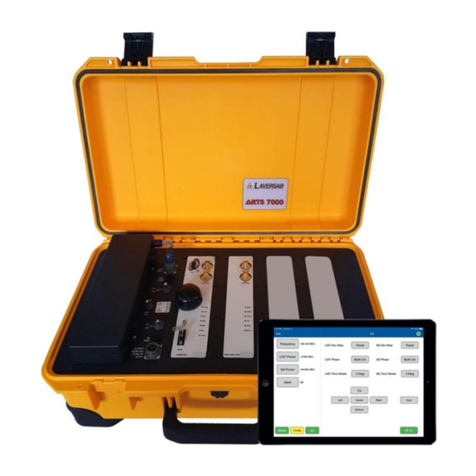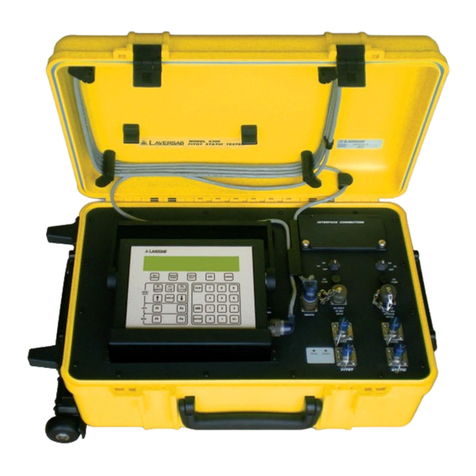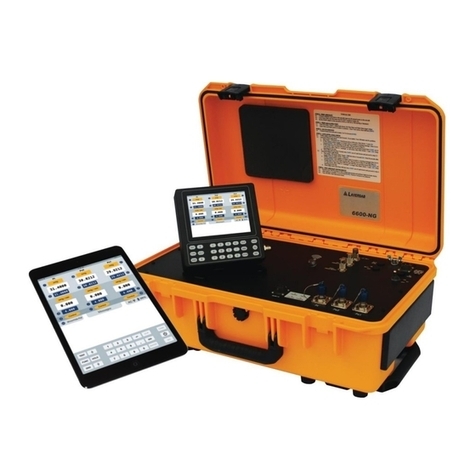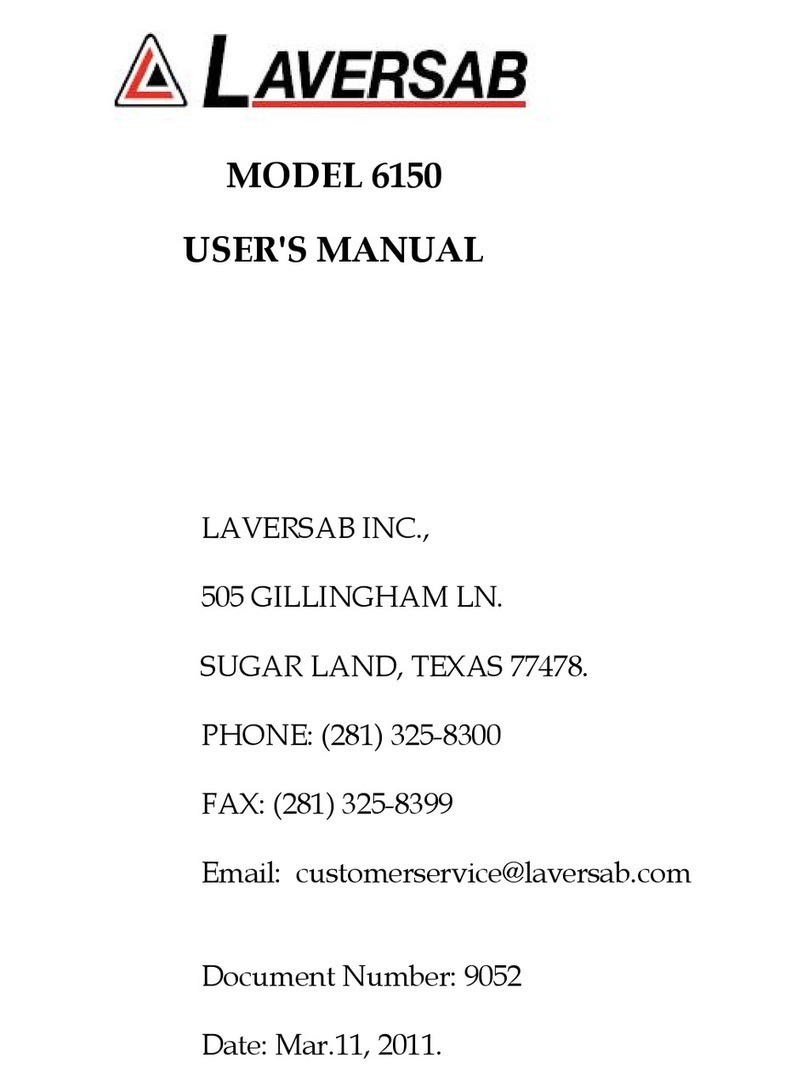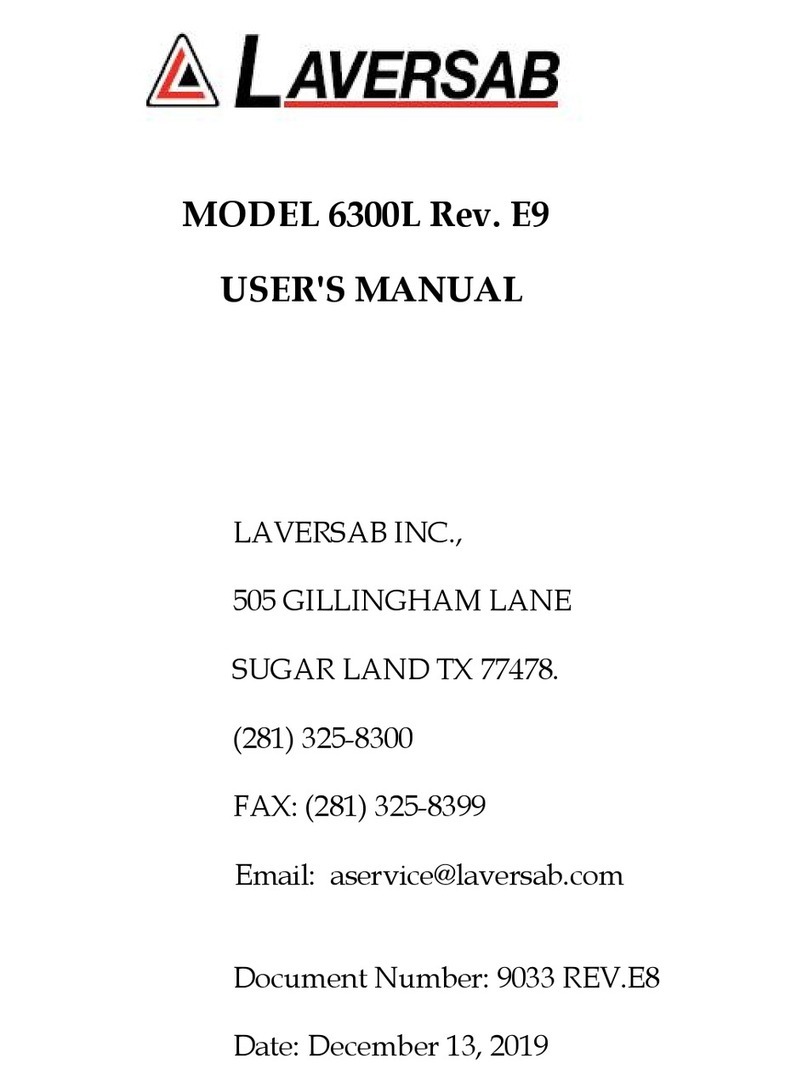Laversab 6500 User manual

MODEL 6500 Rev. F4
USER'S MANUAL
LAVERSAB INC.,
505 GILLINGHAM LANE
SUGAR LAND TX , 77478
(281) 325-8300
AX: (281) 325 8399
Email: aservice@laversab.com
Document Number : 9014 REV. 4
Date: ebruary 23, 2011.
http://www.avionteq.com/Laversab-6500-Automated-Air-Data-Test-Set.aspx
www.avionteq.com
To buy, sell, rent or trade-in this product please click on the link below:

i
WARRANTY
Laversab Inc., warrants its products to conform to or exceed the specifications as
set forth in its catalogs in use at the time of sale and reserves the right, at its own
discretion, without notice and without making similar changes in articles previously
manufactured, to make changes in materials, designs, finish, or specifications. Laversab
Inc. warrants products of its own factory against defects of material or workmanship for a
period of one year from date of sale.
Liability of Laversab Inc. under this warranty shall be limited to replacing, free of
charge ( OB Houston, Texas), any such parts proving defective within the period of this
warranty, but Laversab Inc. will not be responsible for transportation charges,
consequential or incidental damages. No liability is assumed by Laversab for damages
that are caused by misuse or abuse of the product.
The warranty of Laversab Inc. is not made for products manufactured by others
which are illustrated and described in Laversab catalogs or incorporated in Laversab
products in essentially the same form as supplied by the original manufacturer.
Warranties of the original manufacturers supplant the warranty of Laversab Inc., but, in
applicable instances, the latter agrees to use its best efforts to have original suppliers make
good their warranties.

ii
COPYRIGHT NOTICE
Copyright (c) 1991 onwards by Laversab Inc. All rights reserved. The content of this
manual may not be reproduced in any form by any means, in part or in whole, without
the prior written permission of Laversab Inc.
DISCLAIMER
No representations or warranties are made with respect to the contents of this user's
manual. urther, Laversab Inc. reserves the right to revise this manual and to make
changes from time to time in the content hereof without obligation to notify any person of
such revision.

iii
REVISION HISTORY
Doc ment No. Release Date Description
9014 Rev A
02/24/1993
6500 User’s Manual
9014 Rev B
06/22/1998
6500 Rev B User’s Manual
9014 Rev C
12/28/2004
6500 Rev C User’s Manual
9014 Rev D
02/15/2005
6500 Rev D User’s Manual
9014 Rev E
06/06/2005
6500 Rev E User’s Manual
9014 Rev
08/27/2009
6500 Rev User’s Manual
9014 Rev 2
03/08/2010
6500 Rev 2 User’s Manual
9014 Rev 3
12/20/2010
6500 Rev 3 User’s Manual
9014 Rev 4
02/23/2011
6500 Rev 4 User’s Manual

iv
WARNING
THE 6500 USES LINE VOLTAGES OR ITS OPERATION WHICH ARE POTENTIALLY
DANGEROUS. IMPROPER OPERATION O THIS EQUIPMENT MAY RESULT IN
PERSONAL INJURY OR LOSS O LI E. HENCE THE EQUIPMENT DESCRIBED IN
THIS MANUAL SHOULD BE OPERATED ONLY BY PERSONNEL TRAINED IN
PROCEDURES THAT WILL ASSURE SA ETY TO THEMSELVES, TO OTHERS AND
TO THE EQUIPMENT.
BE ORE PER ORMING ANY MAINTENANCE, TURN THE POWER O AND
DISCONNECT THE POWER CORD ROM THE POWER SOURCE.
ALWAYS USE A 3-PIN GROUNDED OUTLET AS YOUR AC POWER SOURCE

v
TABLE OF CONTENTS
Warranty ............................................................................................................................. i
Copyright notice, disclaimer .............................................................................................. ii
Revision History ................................................................................................................... iii
Warning ............................................................................................................................. iv
Section 1: Introduction .................................................................................................. 1
Section 2: Controls and Connections ........................................................................ 2
2.1 ront Panel ............................................................................................................... 2
2.2 Rear Panel .................................................................................................................. 7
Section 3: Understanding the 6500 .............................................................................. 10
3.1 Start Up ..................................................................................................................... 10
3.2 Main Operating Screen .......................................................................................... 12
3.2.1 Displayed Parameters ................................................................................... 12
3.2.2 Target Value Entry ........................................................................................ 18
3.2.3 Units Selection ............................................................................................... 20
3.2.4 Mode Selection ............................................................................................... 22
3.3 Leak Screen ............................................................................................................. 25
3.3.1 Timed-Leak Screen ........................................................................................ 27
3.4 Self Test Screen ........................................................................................................ 30
3.5 unction Select Screen ............................................................................................ 31
3.5.0 unction 0: IEEE Address ............................................................................ 32
3.5.1 unction 1: View Limits .............................................................................. 32
3.5.2 unction 2: Set Limits .................................................................................. 33
3.5.3 unction 3: Set Knots Rate ........................................................................... 35
3.5.4 unction 4: View and Execute Profiles ....................................................... 35
3.5.5 unction 5: Setup Profiles ............................................................................. 36
3.5.6 unction 6: Height Correction .................................................................... 36
3.5.7 unction 7: Set Ground ................................................................................ 37
3.5.8 unction 8: Go To Ground .......................................................................... 37
3.5.8 unction 9: Encoder ...................................................................................... 38
Section 4: Profiles ........................................................................................................... 39
4.1 What is a Profile ...................................................................................................... 39
4.2 Creating a Profile .................................................................................................... 41
4.3 Setting Up Hyperterminal ................................................................................... 42
4.4 Downloading a Profile ........................................................................................... 43
4.5 Executing a Profile .................................................................................................. 44
Section 5: Typical Use ................................................................................................... 46
Section 6: Calibration .................................................................................................... 47
6.1 Equipment ............................................................................................................... 47

vi
TABLE OF CONTENTS (contd.)
6.2 General Notes ............................................................................................................ 47
6.3 Ps Calibration ........................................................................................................... 48
6.4 Pt Calibration ........................................................................................................... 49
Section 7: Maintenance ................................................................................................. 53
Section 8: Communication Interface ............................................................................ 54
8.1 RS232 Serial Interface .............................................................................................. 54
8.2 IEEE-488 Interface .................................................................................................... 54
8.3 Communication Syntax ........................................................................................... 55
Appendix A: Error Codes .................................................................................................. 58
Appendix B: Specifications ................................................................................................ 59
Appendix C: Repair and Return Policies ........................................................................ 60

1
SECTION 1
INTRODUCTION
Note: Pt = Pitot and Ps = Static
The model 6500 is a high accuracy automated pressure controller, specifically designed for
controlling air data parameters such as altitude, airspeed, Mach and climb. This instrument
can also be used to control pressures in units of inHg and mbar. The 6500 requires external
vacuum and pressure supplies in order for it to perform the control function.
The 6500 has two high accuracy transducers that measure pressure in the range of 0 to 38
inHg absolute on the Ps (static) output, and 0 to 100 inHg absolute on the Pt (pitot) output.
These transducers are designed to accurately measure the pressure of dry air over an ambient
temperature range of 0
o
C to 50
o
C. The 6500 is fully RVSM compliant.
The 6500 allows the user to control altitude in feet or meters, climb in feet per minute or
meters per minute, airspeed in knots, mach, mph and kmph. It also allows the user to control
EPR on the pitot output.
The model 6500 features programmable limits on altitude, airspeed, mach number, and climb
rate. These limits are checked during data entry and thereby prohibit entry of erroneous
target values. These limits are also checked continuously during operation, and if any of these
is exceeded, the unit automatically takes abortive action.
The user has the ability to program into the 6500 a profile of set-points to be controlled in a
sequence. Once such a profile has been setup, the user can command the unit to move from
one set-point to the next simply by pushing the 'GO' button. Up to 50 points can be stored in
one profile. The 6500 can store up to 20 such profiles in non-volatile memory at any one time.
Calibration of the unit is required only once a year. This process is the only scheduled
maintenance function required on the 6500.
The model 6500 comes with an RS232 interface. This interface is mainly used to download
profiles from a computer. The high accuracy of the 6500 and its ease of use make it the ideal
Air Data Controller for an instrument shop.

2
SECTION 2
CONTROLS AND CONNECTIONS
Note: Pt = Pitot and Ps = Static
2.1 FRONT PANEL
The front panel of the 6500 is shown in igure 2.1 The various components of the front panel
are described below.
[1] Power ON/OFF switch
This is a Push On / Push Off switch. In the depressed position the switch in ON. This switch
is used to connect AC power to the unit. When power is applied to the unit, the front panel
display will be illuminated.
[2] Contrast Control knob
This single-turn knob is used to adjust the viewing angle of the display.
[3] Remote Connection
An optional Remote Unit may be connected to the 6500 at this connector.
[4] Ps Test Port
This 1/8 – NPT port is the Ps (Static) port of the unit. This port can be used to connect to the
Static port of the Unit Under Test (UUT). This port will have a factory-installed AN-4 fitting.
This port is “Teed” into the Ps port on the rear panel.
Ca tion: If this port is not connected to a UUT then it m st be pl gged/ capped while the
6500 is operational.
Ca tion: A Unit Under Test m st not be connected to this port or disconnected from this
port nless the 6500 is in Meas re Mode.
Ca tion: Do not connect the UUT to this port while performing the Self Test.

3

4

5
[5] Pt Test Port
This 1/8 – NPT port is the Pt (Pitot) port of the unit. This port can be used to connect to the
Pitot port of the Unit Under Test (UUT). This port will have a factory-installed AN-4 fitting.
This port is “Teed” into the Pt port on the rear panel.
Ca tion: If this port is not connected to a UUT then it m st be pl gged/ capped while the
6500 is operational.
Ca tion: A Unit Under Test m st not be connected to this port or disconnected from this
port nless the 6500 is in Meas re Mode.
Ca tion: Do not connect the UUT to this port while performing the Self Test.
[6] KEYPAD & LCD DISPLAY
The back-lit LCD display has 4 lines of 40 characters each. The viewing angle of the display
can be adjusted using the Contrast knob.
There are five function keys just below the display. NEXT SCREEN and PREVIOUS
SCREEN are used to move between the different operating screens of the 6500. At present
there are only three upper level operating screens : Main, Calibrate and Self test.
The FUNCTION SELECT key is used to go into a screen which allows the user to choose any
one of ten functions. The functions are:
0. Set IEEE address
1. View Limits
2. Set Limits
3. Set Knots rate
4. Execute profile
5. Setup profile
6. Height Correction
7. Set “Ground”
8. Go to “Ground”
9. Encoder
These functions are described in detail in Section 3.
The GO key is used to execute all changes made through the Remote unit. After the changes
have been 'ENTER' ed, they will flash on the screen until executed by the GO key. This allows
for simultaneous execution of several changes in target values, modes, units etc.

6
The CANCEL key has multiple purposes. It is used to abort all changes that are flashing on
the screen. It is also used to exit out of target value entry, unit selection and mode selection.
It is used to exit out of other screens like Leak test and unction select. The CANCEL key is
also used to acknowledge error messages or exit an executing profile.
NUMERIC KEYS :
These keys are used for numeric entry of target values and other numeric data. The '+/-' key
operates just like on a calculator and is used to enter negative values. This key must be used
after entering the positive value, to make it negative. The '000' key allows the entry of three
consecutive zeroes.
The CLR key is used to clear the data entry field.
The ENTER key is used to accept numeric entries and also select units and modes.
TARGET VALUE KEYS :
There are typically 3 parameters that the 6500 controls - Altitude, Climb and Airspeed. Each
parameter has its own target value key. The Pt/AIRSPEED key is used to select Pt or
Airspeed target value entry, the Ps RATE/CLIMB key is used to select Climb value entry, and
the Ps/ALTITUDE key is used to select Ps or Altitude value entry. After selecting the target
value key, the new value can be entered using the numeric keypad.
The UP ARROW and DOWN ARROW keys are used to “Jog” a target value. The arrow keys
are also used to move between various choices during Unit selection and Mode selection. or
more information, please refer to Section 3.2.2.
The HOLD key is used to hold the outputs at their current Actual value. This is explained in
detail in Section 3.2.2.
UNITS SELECT KEYS :
Units can be selected independently for the Pt and Ps outputs. Pressing the Pt UNITS key
will bring up the choices in Pt units onto the 4th line of the display. To exit from this selection
mode, press CANCEL. To move between the choices use the arrow keys. There are nine Pt
units in all. The cursor location is indicated by the blinking unit mnemonic. Once the cursor
is on the desired units, press 'ENTER' to select that unit.
The Ps UNITS key brings up the choices for Ps units onto the 4th line of the display. Use
CANCEL to exit this unit selection mode. Use the arrow keys to move between the choices.
Use the ENTER key to select a choice. There are four Ps units to choose from.

7
or more information on Units Selection please refer to Section 3.2.3.
MODE SELECT KEYS :
These keys are used to select between one of three operating modes. Pressing these keys
brings up the selection of modes onto the 4th line of the display. The desired selection can be
chosen by moving the cursor using the arrow keys and then pressing ENTER. The GO key
will execute the entered selection. Modes can be selected independently for the Ps and Pt
outputs.
or more information on Mode Selection please refer to Section 3.2.4.
2.2 REAR PANEL
The rear panel of the 6500 is shown in igure 2.2 The various components of the front panel
are described below.
[1] Vac m Port (2 each)
These ports are used for connecting a vacuum supply to the 6500. A vacuum supply of 0.3
inHg absolute or lower is ideal, and must be connected to both vacuum ports for proper
operation. The vacuum supply must be capable of achieving a pressure that is at least 0.5
inHg lower than the lowest desired controllable pressure on the 6500; i.e. if the lowest
controllable pressure is 2.0 inHg absolute then the vacuum supply must be capable of
generating 1.5 inHg absolute or lower.
Ca tion: If an oil-based vac m p mp is sed then do not t rn off the p mp while it is
still connected to the vac m port of the 6500, as this may ca se severe damage to the 6500.
[2] Press re port (2 each)
These ports are used for connecting the pressure supply to the 6500. A clean, DRY AIR (not
Nitrogen) pressure supply of 110 inHg absolute (80 inHg gauge or 40 psig) is ideal, and must
be connected to both pressure ports for proper operation. The pressure supply must be at
least 5 inHg higher than the highest desired controllable pressure on the 6500.
Ca tion: Do not t rn off the 6500 while the press re s pply is connected to it, as this may
ca se severe damage to the 6500 and/or the UUT.
Ca tion: The press re s pply m st be clean, Dry Air only. Using any other medi m will
ca se significant acc racy errors.

8
[3] IEEE-488 port
If the “IEEE” option is provided on the 6500, a standard 24-pin female IEEE-488 interface
connector is available on the rear panel. Remote communication with the 6500 is possible
through this interface. or more details on using this interface, please refer to Section 8.
[4] RS232 interface connector:
The connector is a standard DB-9 female connector used for a serial RS232 interface. It can be
connected directly to the “COM” port of a standard PC to allow communication. This port is
normally used for downloading “profiles” from a computer. Other remote communication
with the 6500 is also possible through this interface. or more details on downloading
profiles, please refer to Section 4. or more details on communication with the 6500, please
refer to Section 8.
[5] AC inp t connector and F se
A 5x20 mm fuse is located inside the fuse holder. The fuse is a time-delay fuse with a rating of
1.0 amp, 250 Volts.
The 6500 will accept AC voltages between 90-260 VAC, 47-440 Hz. Typical power
consumption is less than 80 VA.
Ca tion: A power cord with a s itable Earth connection m st be sed to power the 6500
to prevent the possibility of a shock hazard.
[6] Circ lating Fan intake
The intake for the circulating fan must not be blocked. Periodically, the filter on this intake
must be cleaned.
[7] Ps Port
This 1/8 – NPT port is the Ps (Static) port of the unit. This port can be used to connect to the
Static port of the Unit Under Test (UUT). This port will have a factory-installed AN-4 fitting.
This port is “Teed” into the Ps port on the front panel.

9
Ca tion: If this port is not connected to a UUT then it m st be pl gged/ capped while the
6500 is operational.
Ca tion: A Unit Under Test m st not be connected to this port or disconnected from this
port nless the 6500 is in Meas re Mode.
Ca tion: Do not connect the UUT to this port while performing the Self Test.
[8] Pt Port
This 1/8 – NPT port is the Pt (Pitot) port of the unit. This port can be used to connect to the
Pitot port of the Unit Under Test (UUT). This port will have a factory-installed AN-4 fitting.
This port is “Teed” into the Pt port on the front panel.
Ca tion: If this port is not connected to a UUT then it m st be pl gged/ capped while the
6500 is operational.
Ca tion: A Unit Under Test m st not be connected to this port or disconnected from this
port nless the 6500 is in Meas re Mode.
Ca tion: Do not connect the UUT to this port while performing the Self Test.

10
SECTION 3
UNDERSTANDING THE 6500
Note: Pt = Pitot and Ps= Static
The 6500 is typically used to calibrate and check air data instruments like altimeters, climb
indicators, and airspeed/ Mach indicators in an instrument shop. This section will explain
how to use the 6500 to perform these functions.
3.1 START UP
Step 1: Open one of the Ps test ports and one of the Pt test ports to ambient
Step 2: Connect power to the 6500 and turn it ON.
Step 3: Connect the pressure supply to the Pressure port of the 6500. Connect the
vacuum supply to the Vacuum port of the 6500.
Note: DO NOT connect the pressure or vacuum supplies until the 6500 has
been turned ON.
DO NOT connect any UUT to the test ports.
The 6500 will turn ON with two beeps. The display will briefly show the sign-on screen and
then go into the Main screen. The Main screen should appear as follows:
Units: knots Feet/min Feet
Actual: M 101.2 3500 1005 M
Target: 20.0 3000 0
The Actual values shown on line 2 will be different from the ones shown above. The 4th line
should be blank.
Before actually using the 6500 to perform certain tasks, it is important to understand how to
use the 6500 to make it do what you want. This section explains everything about the
information that you see on the display, what it means, and

11
Main Leak mode Leak
Operating Screen
Screen
F nction
Select F nction Select
Screens (2)
0
IEEE address
1
View Limits
2
Password Change Limits
3 Change
knots rate
4 Exec te profile
(Ret rn to Main)
5
Set p Profile
6
Height Correction
7
Set Gro nd
8
Go to Gro nd
9
Encoder
Next
Screen Password Calibration
Next
Screen
Self Test Self Test Progress
Fig re 3.1

12
how to change all the parameters that are shown on the display. As we proceed through the
explanations, it will become clearer as to how the 6500 actually operates.
Interaction with the 6500 is done through several different screens that are displayed.. All the
screens are shown in igure 3.1. Of the screens shown in igure 3.1, the Self Test screen is
used only at startup, all the unction Select screens are used only a few times during normal
operation and also when first setting up the 6500. The Calibrate screen is used only once a
year by the calibration facility. During normal operation, the two screens that are used the
most are the Main Operating screen (Main Screen) and the Leak Screen. All the different
screens, except the calibration screen, are explained in this section. The Calibration screen is
explained in section 6.
3.2 MAIN OPERATING SCREEN
Most of the operation of the 6500 is done in the Main Screen. All the pertinent parameters are
displayed on this screen. The screen is also used to change Target values, Units, and Modes.
The following sub-sections explain the various uses of the Main Screen.
3.2.1 DISPLAYED PARAMETERS
There are 11 basic parameters of importance while using the 6500. Each of these parameters is
displayed on the Main Screen. Each parameter is explained below and highlighted in a
sample screen.
Parameter 1. Pitot Units: Unit of measurement for displaying the Pitot output. Normally,
the Pitot unit used is ‘Knots’ for displaying airspeed. Other possible units for displaying the
Pitot output are shown in section 3.2.3, which also explains how to select a particular unit.
The currently selected Pitot unit is shown on the first line of the display (as shown below).
The two values (101.2 and 20.0) that appear below it are in these units.
Units: knots Feet/min Feet
Actual: M 101.2 3500 1005 M
Target: 20.0 3000 0
Parameter 2. Static Units: Unit of measurement for displaying the Static output. Normally,
the Static unit used is ‘ eet’ for displaying altitude. Other possible units for displaying the
Static output are shown in section 3.2.3, which also explains how to select a particular unit.
The currently selected Static unit is shown on the first line of the display (as shown below).

13
The two values (1005 and 0) that appear below it are in these units.
Units: knots Feet/min Feet
Actual: M 101.2 3500 1005 M
Target: 20.0 3000 0
Parameter 3. Climb Units: Unit of measurement for displaying the rate of change of the
Static output, or Climb. Normally, the climb unit used is ‘ eet/min’ for displaying rate of
change of altitude. These units cannot be independently chosen. Whatever the unit selected
for the Static output, the climb unit is the per-minute rate of that selected Static unit. If the
Static unit selected is ‘inHg’ then the climb unit will be ‘inHg/min’. The currently selected
climb unit is shown on the first line of the display (as shown below). The two values (3500
and 3000) that appear below it are in these units.
Units: knots Feet/min Feet
Actual: M 101.2 3500 1005 M
Target: 20.0 3000 0
Parameter 4. Pitot “Act al” val e: This is the current pressure measured at the Pitot
output (Pt test port), displayed in the current units. In the sample screen shown below, the
current pressure at the Pitot output is 101.2 knots. This value is updated every 0.25 seconds.
Units: knots Feet/min Feet
Actual: M 101.2 3500 1005 M
Target: 20.0 3000 0
Parameter 5. Static “Act al” val e: This is the current pressure measured at the Static
output (Ps test port), displayed in the current units. In the sample screen shown below, the
current pressure at the Static output is 1005 eet. This value is updated every 0.25 seconds.
Units: knots Feet/min Feet
Actual: M 101.2 3500 1005 M
Target: 20.0 3000 0
Table of contents
Other Laversab Test Equipment manuals
Popular Test Equipment manuals by other brands

Redtech
Redtech TRAILERteck T05 user manual

Venmar
Venmar AVS Constructo 1.0 HRV user guide

Test Instrument Solutions
Test Instrument Solutions SafetyPAT operating manual

Hanna Instruments
Hanna Instruments HI 38078 instruction manual

Kistler
Kistler 5495C Series instruction manual

Waygate Technologies
Waygate Technologies DM5E Basic quick start guide

StoneL
StoneL DeviceNet CK464002A manual

Seica
Seica RAPID 220 Site preparation guide

Kingfisher
Kingfisher KI7400 Series Training manual

Kurth Electronic
Kurth Electronic CCTS-03 operating manual

SMART
SMART KANAAD SBT XTREME 3G Series user manual

Agilent Technologies
Agilent Technologies BERT Serial Getting started
